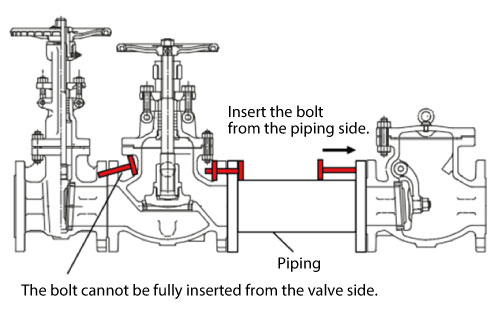Piping condition Questions
- When a pump is installed upstream of a check valve, what distance is required from the pump?
-
① Swing type, lift type, ball type check valves
Chattering may occur because of turbulence, eddy currents, or pulsation of the fluid.
Install the valve with a distance of at least six times the pipe nominal diameter.② Wafer type check valves (excluding stainless steel products)
As for pump discharge, the valve can be directly connected to the pump.③ Stainless steel wafer type check valves
Since the structure is different from wafer type check valves made of other materials, the valve cannot be used by connecting it directly to the pump.
As for pump discharge, ensure a straight pipe section that is at least twice the pipe nominal diameter (at least three times the bore diameter when the pump discharge has a tube expansion of two sizes or more).
- Is it possible to connect stainless steel piping to an aluminum butterfly valve?
-
An aluminum butterfly valve can be used with stainless steel piping.
The parts that come into contact with the fluid are only the disc and the rubber seat, but the disc does not come into contact with the piping and the rubber seat that comes into contact with the piping does not conduct electricity. Therefore, dissimilar metal corrosion does not occur.
- When installing a butterfly valve, what length of bolts / nuts for piping should be used?
-
The required dimensions of hexagon bolts / nuts for piping of butterfly valves are introduced in the catalog. Please refer to it. In addition, the bolts / nuts for piping are not attached to the product.
(General Catalog, Digest Version / Butterfly Valve General Catalog)
- When installing a butterfly valve, are gaskets for piping necessary?
-
For the product whose seat material is rubber (seat rubber), the rubber seat (seat rubber) also plays the role of piping gaskets. Therefore, piping gaskets are not required.
For the product whose seat material is not rubber (seat rubber), piping gaskets are required. Since the types / dimensions of gaskets that can be used may be limited, please refer to the instruction manual / catalog of the product.
(Butterfly Valve General Catalog)
- Is it possible to bury valves for piping?
-
We do not recommend to bury valves for installation. Prepare a valve box even when using a valve for burying.
- Is it possible to connect one valve to another valve directly for piping?
-
We do not recommend connecting the valves directly for piping.
Because of the valve structure, there is a possibility of interference as shown in the figure when passing bolts. Normally, a short pipe is sandwiched and the bolts are inserted from the pipe side, and the nuts are tightened on the valve side. Therefore, when installing a valve and a valve, be sure to use a short pipe to connect them for piping.
- Is it possible to connect a bronze valve to a stainless steel pipe?
-
Bronze and stainless steel are close in electrical potential, so they can be connected.
According to a material issued by the Japan Stainless Steel Association, it is described as “there is no practical problem.” However, please note that we do not recommend for brass valves.
- Do you have a piping compatibility table for butterfly valves?
-
For the piping compatibility table for butterfly valves, please refer to the “General Catalog, Digest Version” and “Butterfly Valve General Catalog”.
(Butterfly Valve General Catalog)
- Tell me the dimensions of the bolts and nuts for piping of wafer type check valves.
-
Please refer to the catalog for the dimensions of the bolts and nuts for piping used for wafer type check valves.
(Wafer type check valves)In addition, the bolts / nuts for piping are attached to the product.
- Tell me the proper piping tightening torque for threaded products.
-
The proper piping tightening torque for threaded products are as follows.
Be careful not to tighten with excessive force.
